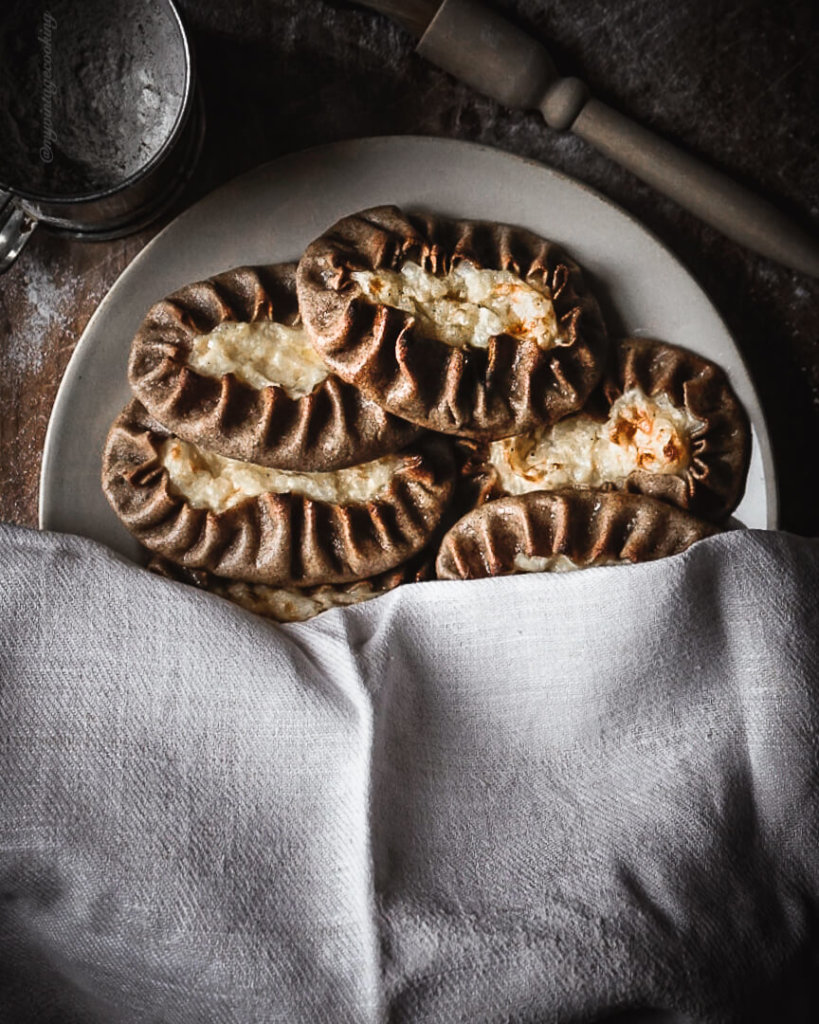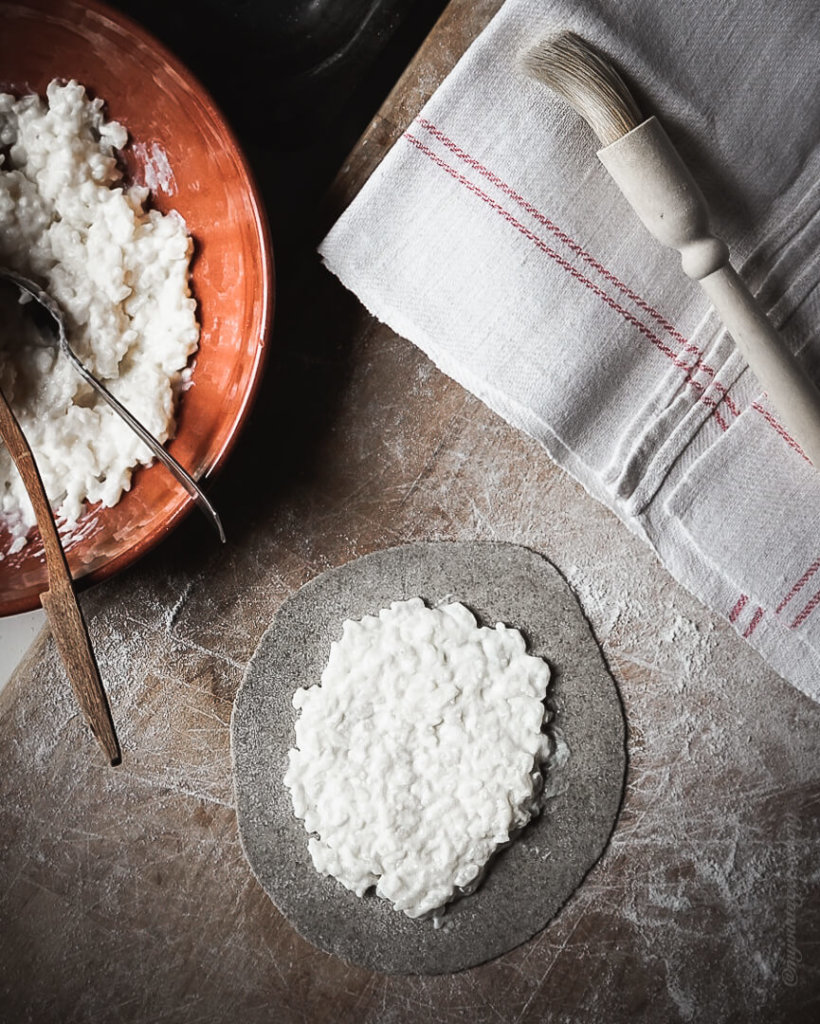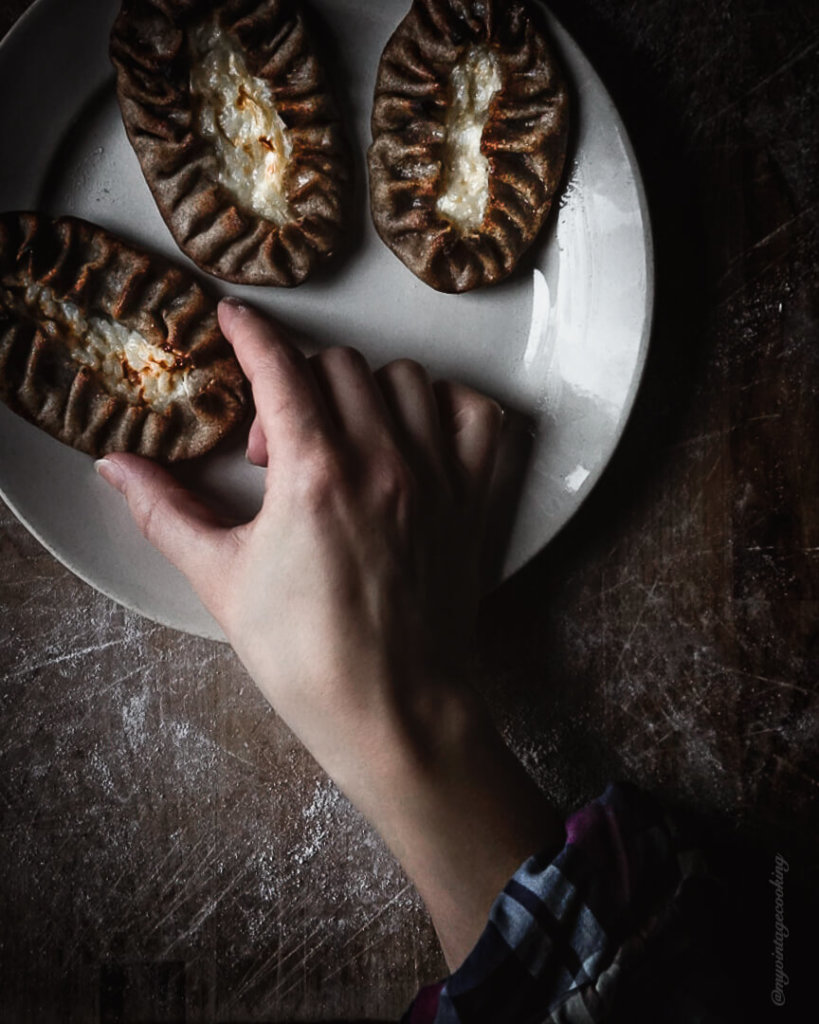Whether you have enjoyed these rye-crusted savory hand pies before or not, save this recipe now. The authentic homemade Karelian pies are best when fresh from the oven but the recipe below gives you enough pies to store in the freezer for later, too.
Yet commercial Karelian pies are a common everyday snack found in every cafe and grocery store across Finland, homemade Karelian pasties are festive food. Truly, each pie is handcrafted and a piece of art.
The first literary notes of Karelian pies are from 1686. However, traditionally rye crusted open pasties are to be found from both sides of the Karelia region across Finland and Russia. The fillings of rye-crusted pies have evolved throughout the time when cultivation diversified. Moreover, the pies have both sweet and savory fillings.
In this post, we’ll bake specifically Karelian pies which name came to be when this savory pasty became popular beyond the Karelia region after the 1940s wars. Karelian pie should not be confused with “Rönttönen” from the Kainuu region.
DISCLAIMER: This post includes affiliate links, meaning that I get a small commission if you choose to make a purchase through the given links. You can distinguish the curated commercial links with an * sign. Read full disclosure here.
What makes the Karjalanpiirakka unique?
The characteristics of Karelian pies are well documented because these unique pasties hold Traditional Speciality Guaranteed (TSG) status in the EU. The Cornish pasties hold the same status, for example, they are to be baked with at least 12.5% beef and 25% vegetable content like in the traditional recipe.
Characteristics and history are valued, the ingredients and process are well known. And this is a good thing because the rye crusted pasties come in different sizes, fillings, and traditions. The following details will give you a good idea of what you should aim for when baking Karelian pirogs.
Karelian pasties…
- are small oval pasties with an open exposed filling in the middle
- have a rather flat profile so you don’t need to exaggerate with the filling
- originally these pies were filled with barley porridge, then potato, and finally with rice porridge when rice became available
- the rye crust is rolled out thin and the pasty bakes crispy in a very HOT oven
- the size of Karelian pies varies between 7cm – 20cm (2.8-7.9 inch)
- the crinkled look is achieved by pressing the folded edges with fingers
Tips for baking Karelian Pies
My husband’s grandmothers are from the old Karelia and he has been pampered with these delicious pies all his life. I, on the other hand, survived long days at the University by snacking on the commercially produced Karelian pasties. They are good too, but the contrast is real.
Because I have had to learn to bake these pies with zero experience, I assure you can bake beautiful Karelian pies, too. My first pasties looked like copies of the store-bought pies and now I’m learning to make them like my husband’s auntie decorates them.
It’s fun to develop your own style of crinkling the edges, there’s no wrong way of doing it.
Keep these tips in mind
- The starting point is making the rice filling. You can prepare it the evening before.
- Making the rye crust is simple, just give rye a moment to settle before kneading all of the flour in.
- Choose finely milled rye flour, it makes a beautifully smooth dough. E.g. King Arthur Classic Medium Organic Rye* and Doves Farm Organic White Rye Flour*
- When making the dough discs, a French rolling pin e.g. this 20-inch pin by Fletchers’ Mill* is your best friend. Don’t have a French rolling pin? Use a dumpling rolling pin but be sure to roll the discs to even thickness.
- The crust is rolled very thin, think about 2mm or 0.07 inches. This makes the crinkling a challenge if you have very long nails (check).
- Karelian pies are baked crispy in a hot oven without parchment paper

Homemade Karelian Pies | Recipe
The following recipe yields somewhat 24-26 Karelian pies. This is a nice even number of pies to bake along with 3-4 sets of trays depending on the size of your oven.
I use a mix of fine medium rye and dark rye. Some recipes also include oil and wheat, I don’t understand why you would want to add them and besides oil doesn’t belong to the authentic ingredient list.
You can make these pasties with any type of rye flour, really. However, the smoothness will be different and you must balance the amount of liquid as you make the dough. Don’t stress.
How to eat Karelian Pasties?
The classic combo is to enjoy Karelian Pies with egg butter. This is a very popular duo on smorgasbord servings and parties. When I bake the potato puree filled pasties, my favorite snack is to warm a pie with cheese.
When fresh and warm from the oven, I don’t need anything extra on top of the pie. The crispy rye crust, the milk-butter dip, and creamy rice filling are all I want to experience.
It’s a good idea to bake a good amount of pies when you decide to make them. It’s a win-win situation – you learn the process and technique while the extra pasties can sit in the freezer for later enjoyment. The 24-26 pies this recipe yields is a perfect starting point to learn baking Karelian pies.
I hope you enjoy this homemade Karelian pies recipe. Do tag me along on Instagram if you bake them, I would love to see. :)
Love, Saara
Want to explore more Finnish recipes?
check HERE










